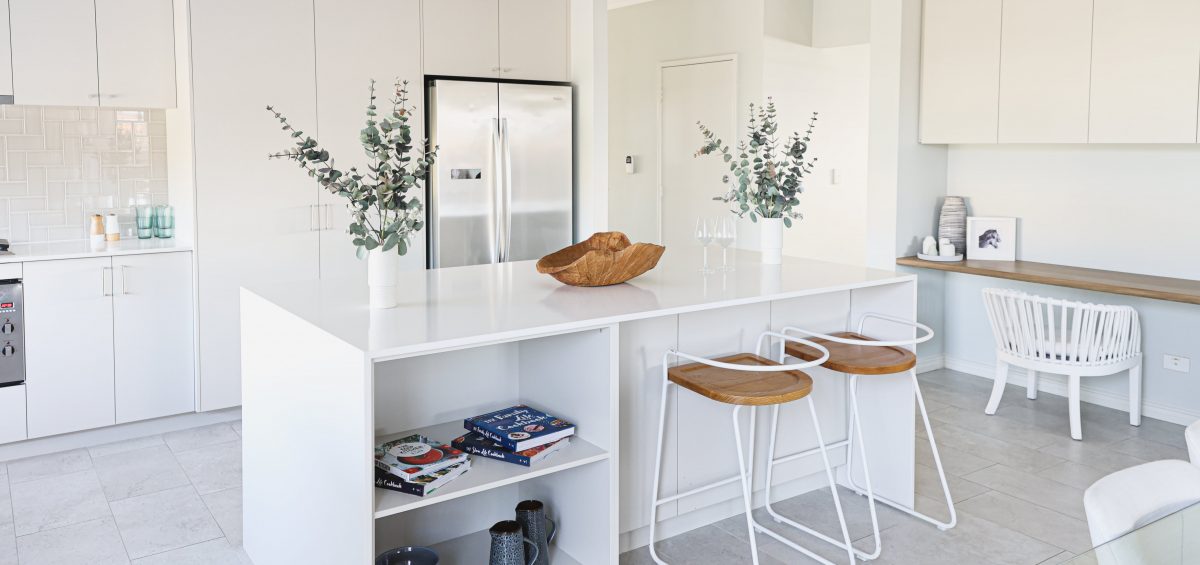The kitchen is often thought of as the heart of the home, where family and friends congregate to cook together and share meals. This makes designing the kitchen a very important step when renovating building a home.
There are several things you need to consider when designing a kitchen to ensure that you have a space that is easy and comfortable to use and suits the needs of you and your family.
Let’s take a look at the main considerations when designing the perfect kitchen for you to follow during the process.
5 Top Considerations When Designing The Perfect Kitchen
1. The Kitchen Island
A kitchen island is a trendy and useful addition to any kitchen space. You can use it for a host of different activities or storage features, which frees up space in your other cabinets.
Another option is making the island a washing space where you install your sinks and drying area. If you opt for this, ensure it is located near the stove so that you can easily transfer dishes that need to be washed.
You can also make the island a dining space. Keep the counter free and throw a few barstools around it to make it an informal eating area or breakfast bar.
Regardless of what you choose to use the island counter for, you can also make the most of the base. Fit in appliances like a dishwasher or a mini-fridge and add storage space where possible.
2. Materials
The materials used on cabinets and counters in a kitchen determine the overall aesthetic and feel of the room.
Start by thinking about the look you are going for and this will inform more specific material choices. Perhaps you want a simple farm-style kitchen, which would entail various woods look laminable like materials for the cabinets. Or, you can opt for a sleek and modern monochrome look with high-gloss acrylic cabinets. You can also go the luxury route with marble on the countertops or get creative with jewel-coloured cabinets.
The type and quality of materials you use will depend on your budget. It does well to invest in good quality material if you can. This will result in a durable kitchen that will not need fixing or replacements for a long time to come – saving you money in the long run!
3. Electrical Outlets
A kitchen needs to house several appliances so configuring electrical outlets in the right locations to serve these is incredibly important.
Start by planning where your appliances will go, such as your kettle, coffee machine, toaster, blender, dishwasher, etc. This gives you an idea of where you will want to place the outlets. Try to keep it as close to the appliances as possible to avoid stretched cords and visible wires.
Install a few extra outlets where possible. You might buy additional appliances in the future or you may want to charge your devices while in the kitchen. For example, USB outlets could be a useful addition to consider.
4. Layout
The layout of a kitchen is arguably the most important part of the design process. It is the foundation of what your kitchen will look and feel like in the end.
When designing the layout, think carefully about the needs of your household. First, consider the space you have available. If it is a smaller house, you might want to opt for an open-plan kitchen so that it feels more spacious.
Ensure it is close enough to your dining room and consider an open plan transition between the two areas so that you can easily transfer food and dishes back and forth.
If you have a big family in your house, you will want a large enough space between counters in the event of more than one person standing and/or cooking in the kitchen at the same time.
If you live in a smaller house, you may want to utilise the kitchen space for a dining area rather than having a separate dining room to save space. If this is the case, the layout should be minimalistic and open so that there is space for a dining table.
Try to keep the sink and stove close enough to one another to avoid walking a long distance when having to transport dishes between the two. If you can, keep the fridge close, too. Going back and forth when cooking can become cumbersome if there is a significant distance between the fridge and the stove.
5. Storage Space
Kitchen cabinets do not just house food but are often used to store crockery, cleaning supplies, and appliances, too. Getting the optimal amount of storage space in the kitchen is crucial in the design process.
If you have the space and budget, a kitchen pantry is incredibly useful to store all dry food products and appliances that aren’t used often. It allows you to keep everything in one place and you will have the other cabinets just for pots, cutlery, crockery, and glassware.
If you do not have the space for a pantry and need to rely solely on the kitchen cabinets, try to keep all food products close to the stove area for convenience. You can install spice racks around the range area, and keep any seasoning and oils, or anything else frequently used, in the cupboards closest to the cooking area.
A cabinet below or next to the stove can be used for pots, pans, and casseroles, while a cabinet below the sink is ideal for cleaning products.
Ensure shelves are easy to access. Anything installed too high up becomes a waste of space if it is out of reach.
Key Takeaways For Designing The Perfect Kitchen
Designing the perfect kitchen gives life to your home, making it an integral part of the overall home design process.
At New Homes WA, we’re ready to help design and create your dream kitchen. We’ll advise you on the design process and help you determine the best materials and layout to suit your needs.




